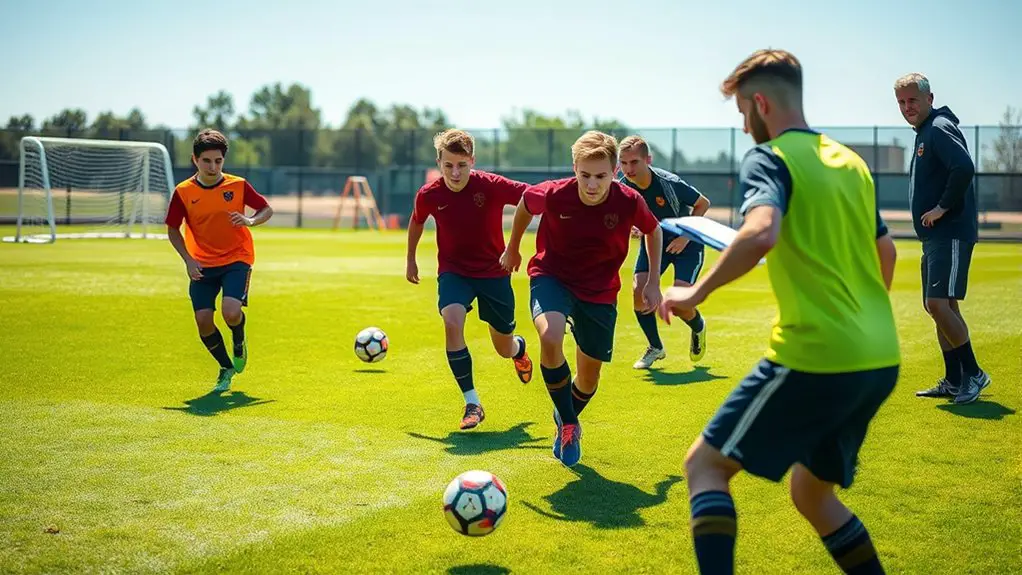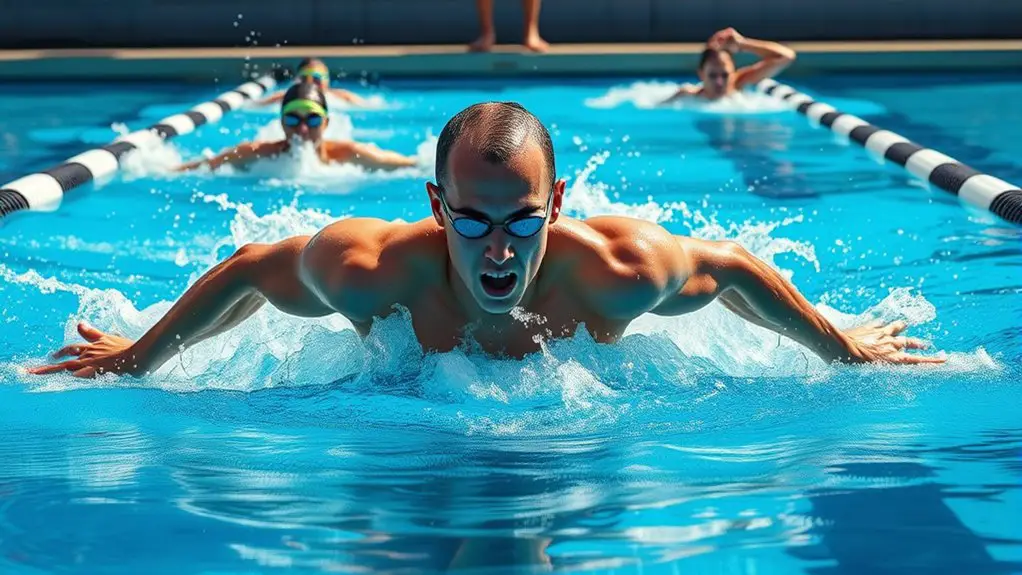To improve your defensive skills in soccer, focus on shadowing and marking drills, 1v1 challenges, and zonal defense exercises. Practicing intercepting and anticipation drills will sharpen your decision-making and positioning. Don't forget about recovery runs and changeover training to get back into shape quickly after losing possession. Engaging in small-sided games boosts your understanding of teamwork and communication. Stick around, and you'll discover even more valuable techniques to elevate your defensive game!
Shadowing and Marking Drills
When it comes to defensive skills, shadowing and marking drills are essential for any soccer player looking to sharpen their game. These drills help you develop critical shadowing techniques that allow you to stay close to your opponent without compromising your position. You'll learn how to read their movements, anticipating their next steps while maintaining your balance and agility.
Marking strategies are equally important. Whether you're playing man-to-man or zone defense, knowing when to close down on an attacker or when to provide support can make all the difference. Incorporating these strategies into your practice sessions helps you build confidence and awareness on the field. Additionally, mastering proper foot placement aids in maintaining balance and stability during these defensive maneuvers.
1v1 Defensive Challenges
Building on the foundation of shadowing and marking, v1 defensive challenges take your skills to the next level by simulating game-like situations. In these drills, you'll face an attacker one-on-one, allowing you to sharpen your defensive footwork and enhance your tackling techniques. You'll need to stay light on your feet, ready to pivot and react.
As the attacker moves, focus on maintaining a balanced stance, using your body to shield the ball while keeping your eyes on the opponent's feet. This not only builds your confidence but also fosters a sense of freedom in your movements. Each challenge hones your instincts, teaching you when to engage and when to hold back.
Embrace the intensity of these drills, and you'll find yourself becoming a more dynamic defender on the field. With practice, you'll turn these challenges into opportunities for growth and mastery.
Zonal Defense Exercises
While mastering individual defensive skills is essential, understanding zonal defense is equally important for effective team play. Zonal awareness helps you and your teammates cover space efficiently, creating a strong defensive unit. Here are some exercises to enhance your defensive coordination:
| Exercise | Description | Purpose |
|---|---|---|
| Zone Marking Drill | Players practice staying in their zones while marking opponents. | Develops zonal awareness |
| Triangle Defense | Form a triangle around an attacker to practice support. | Improves teamwork and spacing |
| Switching Drills | Work on switching zones quickly in response to ball movement. | Enhances adaptability |
| Pressure Relief | Rotate in zones to apply pressure and relieve teammates. | Builds communication skills |
Incorporate these exercises into your training sessions, and watch how your understanding of zonal defense transforms your game. Embrace the freedom that comes with coordinated team defense! Additionally, enhancing your flexibility and range of motion through mobility training can further improve your defensive capabilities on the field.
Intercepting and Anticipation Drills
To excel in defense, you need to sharpen your anticipation skills and learn effective intercepting techniques. By developing the ability to read the game, you'll position yourself better to cut off passes. Let's explore some drills that can help you master these essential skills.
Anticipation Skill Development
Anticipation is essential for defenders, as it allows you to read the game and position yourself effectively to intercept passes. Developing your anticipation skills means practicing techniques that enhance your awareness on the field. Here are some effective drills to boost your anticipation abilities:
| Drill Name | Purpose |
|---|---|
| Shadow Play | Improve reading plays and positioning |
| Reaction Drill | Enhance quick decision-making |
| 1v1 Scenarios | Develop tactical awareness |
| Intercept Passing | Sharpen interception techniques |
Intercepting Passing Techniques
As you work on intercepting passing techniques, mastering the art of reading your opponent's intentions becomes essential. Pay close attention to passing angles; they'll give you clues about where the ball's headed. Position yourself strategically to cut off those paths, and don't forget about interception timing. The moment you sense a pass is about to be made, spring into action.
Practice drills that simulate game scenarios, allowing you to sharpen your instincts. Work with a partner to create unpredictable passing situations and focus on your reaction speed. The more you train your mind to anticipate plays, the more successful you'll be at intercepting. Freedom on the field comes from confidence in your ability to read and react effectively.
Recovery Runs and Transition Training
Recovery runs and changeover training are essential components for soccer players looking to enhance their defensive skills. These drills not only improve your endurance but also help you master recovery techniques after losing possession. When the ball shifts to the other team, quick recovery runs allow you to reposition and be ready for the next play.
Focus on implementing shift strategies during practice. For instance, simulate game scenarios where you must quickly switch from offense to defense. Work on sprinting back into defensive shape, keeping your eyes on the ball, and anticipating your opponent's moves. Incorporating lateral movement into these elements of your training routine will give you the freedom to make decisive plays on the field. Remember, the faster you can recover and adjust, the more effective your defense will be. So, embrace these drills, and watch your defensive game elevate!
Clearances and Ball Control Techniques
Mastering clearances and ball control techniques is essential for any soccer player looking to strengthen their defensive game. When you're under pressure, knowing the right clearance techniques can make all the difference. Practice different methods like the overhead kick or driven clearance to get comfortable sending the ball away from danger.
For effective ball handling, focus on your first touch. A solid first touch can help you maintain possession and set up your next move. Dribble under pressure and work on quick, decisive touches to evade opponents.
Combine these skills by simulating game scenarios during drills. Set up a practice that involves receiving a pass, controlling the ball, and executing a clearance. Additionally, incorporating footwork drills into your routine will enhance your agility and responsiveness on the field. By integrating these techniques into your training, you'll build confidence and improve your overall defensive performance on the field. Embrace the freedom of movement and decision-making to truly elevate your game.
Positioning and Spacing Drills
Positioning and spacing are essential aspects of effective defense in soccer, and incorporating targeted drills can make a significant difference in your performance. By focusing on defensive positioning and spacing awareness, you'll develop the ability to anticipate the opponent's moves and make timely interventions.
Here are some drills to improve your skills:
| Drill | Description |
|---|---|
| Shadowing | Pair up and mirror each other's movements. |
| Cone Dribbling | Navigate through cones while maintaining space. |
| 1v1 Defending | Practice defending against an attacker. |
| Zone Defense | Work on covering designated zones as a team. |
These drills not only enhance your individual skills but also strengthen team dynamics. By integrating them into your training routine, you'll gain confidence in your defensive abilities and maintain better control over your positioning and spacing on the field.
Small-Sided Games for Defensive Work
Small-sided games are essential for honing your defensive skills in a dynamic environment. In two-on-one situations, you'll learn how to effectively position yourself and make critical decisions under pressure. Additionally, possession-based drills help sharpen your ability to read the game and anticipate opponents' moves.
Two-on-One Situations
While engaging in two-on-one situations, players can greatly enhance their defensive skills by learning how to effectively contain attackers. This drill focuses on applying pressure while utilizing smart defensive tactics. You'll need to communicate with your partner to guarantee you're both on the same page.
| Player Role | Action |
|---|---|
| Defender 1 | Apply pressure on the attacker while cutting off angles. |
| Defender 2 | Anticipate the attacker's moves and provide support. |
| Attacker | Attempt to evade both defenders and create space. |
| Overall Strategy | Maintain a compact formation to limit options. |
Mastering these dynamics in a two-on-one scenario will give you the confidence to handle more complex game situations effectively.
Possession-Based Defensive Drills
Possession-based defensive drills are essential for developing a player's ability to regain the ball while also honing their tactical awareness. In small-sided games, you'll focus on ball retention and understanding how to apply pressure effectively. By engaging in these drills, you'll learn to anticipate your opponent's moves, positioning yourself strategically to cut off passing lanes and force turnovers.
These games encourage communication and teamwork, allowing you to experience real-game scenarios where quick decisions matter. You'll discover the balance between maintaining your defensive shape and putting pressure on the ball carrier. Embracing these challenges will not only enhance your defensive skills but also give you the freedom to express yourself on the field while contributing to your team's success.
Communication and Teamwork Activities
How can effective communication and teamwork elevate a soccer team's defensive performance? When players share a common language on the field, it transforms their defensive strategy. Implementing solid communication strategies and teamwork exercises can create a fluid, synchronized unit that anticipates opponents' moves, making it harder for them to penetrate your defense.
Here's a quick overview of how communication and teamwork can impact your game:
| Positive Outcomes | Negative Outcomes |
|---|---|
| Increased trust and support | Confusion and hesitation |
| Enhanced tactical awareness | Missed assignments |
| Stronger defensive lines | Vulnerable to counterattacks |
Frequently Asked Questions
How Can I Improve My Overall Defensive Mindset?
To improve your overall defensive mindset, focus on your defensive awareness and tactical positioning. Keep your head up during play, scanning the field to anticipate opponents' moves. Practice staying aware of both the ball and your positional play, adjusting your stance as needed. Embrace challenges, and don't shy away from communicating with teammates. Remember, it's about being proactive, not reactive, giving you the freedom to control the game and make impactful decisions.
What Are Common Mistakes to Avoid in Defensive Drills?
Avoiding common mistakes in defensive drills can be vital for your growth. To begin with, don't disregard the key defensive principles—positioning and anticipation matter! In addition, neglecting effective communication techniques can lead to confusion on the field. You want to be a cohesive unit, right? Remember, practice with purpose, and don't let impatience hinder your progress. Embrace each drill as a chance to enhance your skills and enjoy the freedom of playing your game!
How Often Should I Practice Defensive Drills?
When it comes to defensive drill frequency, it's important to find a balance that fits your practice schedule. Aim for at least two to three sessions a week, but don't overdo it. You want to keep things fresh and enjoyable! Mix in some rest days to prevent burnout. Experiment with different drills and intensities, and listen to your body. This way, you'll improve your skills while still having the freedom to enjoy the game.
What Fitness Level Is Required for Effective Defensive Training?
Oh sure, you think you can just waltz into defensive training without a fitness assessment? Think again! To really excel, you've gotta be in tip-top shape. Agility training's essential; it'll help you dodge those attacks like a pro. So, if you're not sweating buckets and feeling the burn, you might wanna rethink your fitness level. Embrace the grind, and you'll find freedom on the field, ready to defend like a warrior!
How Can I Track My Defensive Progress Over Time?
Tracking your defensive progress over time's essential for improving your skills. You can start by keeping defensive statistics, like tackles made and interceptions. Regular progress assessments, like reviewing game footage or seeking feedback from coaches, can help you identify areas for growth. Celebrate your achievements, no matter how small, and adjust your training based on what you learn. Embrace the journey, and you'll see how much you've improved.




